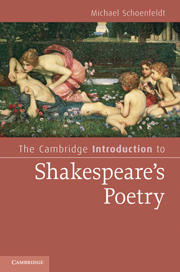Book contents
- Frontmatter
- Contents
- Acknowledgments
- Chapter 1 Shakespeare and English poetry
- Chapter 2 Shakespeare's banquet of sense
- Chapter 3 Constraint and complaint in Lucrece
- Chapter 4 Mysteries of the Sonnets
- Chapter 5 Time and mortality in the Sonnets
- Chapter 6 Friendship and love, darkness and lust
- Chapter 7 Solitary and mutual flames
- Chapter 8 Fantasies of Shakespearean authorship
- Notes
- Further reading
- Index
- Cambridge Introductions to Literature
Chapter 1 - Shakespeare and English poetry
Published online by Cambridge University Press: 05 June 2012
- Frontmatter
- Contents
- Acknowledgments
- Chapter 1 Shakespeare and English poetry
- Chapter 2 Shakespeare's banquet of sense
- Chapter 3 Constraint and complaint in Lucrece
- Chapter 4 Mysteries of the Sonnets
- Chapter 5 Time and mortality in the Sonnets
- Chapter 6 Friendship and love, darkness and lust
- Chapter 7 Solitary and mutual flames
- Chapter 8 Fantasies of Shakespearean authorship
- Notes
- Further reading
- Index
- Cambridge Introductions to Literature
Summary
Anyone can be creative; it's rewriting other people that's a challenge.
– Bertolt BrechtMost students and some scholars are surprised to learn that Shakespeare's greatest publishing success in his lifetime was Venus and Adonis. They are also surprised to learn that Shakespeare at his death was at least as well known for his non-dramatic poetry as for his work in the theater. Attention to the non-dramatic poetry tends to get swamped by the interest inevitably generated by the remarkable and sustained accomplishment of the plays. This tendency to marginalize the non-dramatic verse is a process at least as old as the First Folio of 1623, in which the compilers, for whatever reason, fail to include Venus and Adonis, Lucrece, the Sonnets, and “The Phoenix and Turtle,” in their collection of Shakespeare's works. Prior to the First Folio, though, the tendency was for publishers to advertise Shakespeare's accomplishments in non-dramatic poetry. William Jaggard, whose son Isaac published the First Folio, had in 1599 issued a work designed to capitalize on Shakespeare's growing fame as a poet: The Passionate Pilgrim (1599). A collection of twenty poems purported to be by Shakespeare, this volume prints several poems from an early comedy by Shakespeare, Love's Labour's Lost, as well as versions of two of the sonnets that would eventually be published in the 1609 Sonnets, and several poems by other poets.
- Type
- Chapter
- Information
- The Cambridge Introduction to Shakespeare's Poetry , pp. 1 - 18Publisher: Cambridge University PressPrint publication year: 2010

